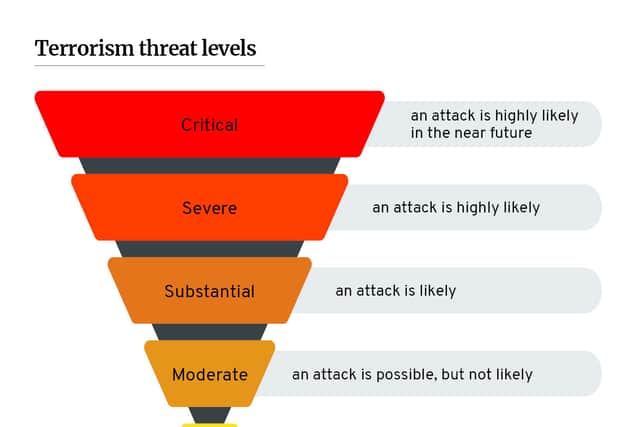What are the UK terror threat levels? Why terrorism level has been reduced, by who and what each stage means
and live on Freeview channel 276
UK’s terrorism threat level has been reduced from severe to substantial, meaning the chance of an attack occurring is now “likely”.
The threat level had been raised to “highly likely” in November 2021 following an explosion at Liverpool Women’s Hospital.
Advertisement
Hide AdAdvertisement
Hide AdThe incident saw a taxi explode and engulf in flames in the drop off zone outside a reception area of the hospital on Remembrance Sunday.
The explosion killed the passenger and injured the driver, who managed to lock the suspected terrorist inside the taxi and escape before the vehicle caught fire.
The driver, named locally as David Perry, has been heralded a hero.
Here’s what the UK terrorism threat levels mean.
What are the UK terrorism threat levels?
There are five different levels in which the threat of terrorism is decided.
Advertisement
Hide AdAdvertisement
Hide AdThe levels are designed to give a broad indication of the likelihood of a terrorist attack based on sensitive and confidential information.
The five UK terror threat levels are: low, moderate, substantial, severe and critical.


How are the UK terrorism threat levels decided?
The UK’s terrorism threat levels are decided independently from government ministers by the Joint Terrorism Analysis Centre (JTAC).
It judges the current threat of a terrorist attack and is used by police and other security practitioners to decide what protective operations may be required.
Advertisement
Hide AdAdvertisement
Hide AdDecisions are based on several factors of national security, including available intelligence, terrorist capability, terrorist intentions and timescale of a likely attack.
What does the ‘substantial’ terrorism threat level mean?
A ‘severe’ terrorism threat level means an attack is highly likely, according to the MI5.
It is one up from ‘substantial’ and one below ‘critical’ in the security service’s five levels used to determine the threat of terrorism on the UK.
- Low: means an attack is highly unlikely
- Moderate: means an attack is possible but not likely
- Substantial: means an attack is likely
- Severe: means an attack is highly likely
- Critical: means an attack is highly likely in the near future
How frequent does the threat level change?
The UK terror threat level changes in accordance to terrorism activity.
Advertisement
Hide AdAdvertisement
Hide AdPrior to November 2021, the last time the UK terrorism threat level was ‘severe’ was November 2020. It was lowered to ‘substantial’ in February 2021.
Prior to that it had been ‘substantial’ - meaning an attack was likely - for almost a year, after the threat level was ‘severe’ from July 2019 to November 2019.
The UK’s national terrorism threat level is currently ‘substantial’.
Home secretary Priti Patel told MPs: “The decision to change the UK terrorism threat level is taken by JTAC independently of ministers.
Advertisement
Hide AdAdvertisement
Hide Ad“JTAC keep the threat level under constant review based on the very latest intelligence and analysis of internal and external factors which drive the threat.
“Any reduction in the threat level is positive but it must never make us complacent. Terrorism remains one of the most direct and immediate risks to our national security. The public should remain alert, but not alarmed, and report any concerns they may have to the police.”
The threat level of international terrorism had changed 23 times since it was first published in August 2006.
A message from the editor:
Thank you for reading. NationalWorld is a new national news brand, produced by a team of journalists, editors, video producers and designers who live and work across the UK. Find out more about who’s who in the team, and our editorial values. We want to start a community among our readers, so please follow us on Facebook, Twitter and Instagram, and keep the conversation going. You can also sign up to our email newsletters and get a curated selection of our best reads to your inbox every day.
Comment Guidelines
National World encourages reader discussion on our stories. User feedback, insights and back-and-forth exchanges add a rich layer of context to reporting. Please review our Community Guidelines before commenting.
